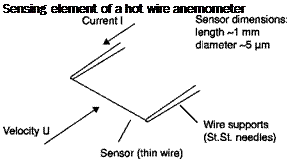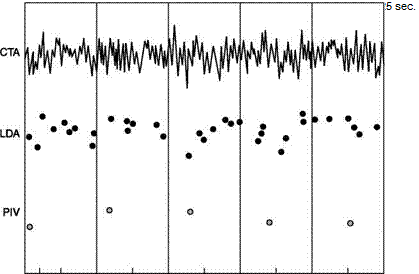Hot wire anemometer
Abstract: This chapter will address the measurement of velocity in unsteady flows in 1D, 2D and 3D fields obtained with hot wire anemometers, from the first analog constant current anemometer in the 1930s to the current solid state digital constant temperature anemometer.
Key words: hot wire, King’s law, turbulence intensity.
3.1 Introduction
As seen in Chapter 2, speed can be obtained from pressure measurements only in almost stationary streams. In turbulent flows it is necessary to use the hot wire anemometer, which has a very high frequency response, or, alternatively, the laser-Doppler anemometer (LDA), the laser-2 focus anemometer (L2F), which are able to infer the intensity of turbulence from a statistical survey of the speeds of many particles carried by the stream.
The sensor of the hot wire anemometer (Figure 3.1) is a metallic wire heated by the Joule effect and cooled by the fluid flow. Because the
 |
Figure 3.1
 |
electrical resistance of the wire changes with temperature, by the changes in the difference of potential at the ends of the wire the corresponding changes in flow velocity can be deduced. Fluctuations in speed can be measured, using appropriate electronics, at a very fine scale at high frequency.
The output signal of the hot wire anemometer is compared in Figure 3.2 with those from the laser-Doppler anemometer and particle image vel – ocimetry (PIV): the advantages of hot-wire anemometer on other systems, in addition to being less costly, are the ease of use, the analog output and a high temporal resolution that allows spectral analysis of the signal.
Note that LDA signals (like those of the L2F) are random: a signal is provided each time a particle passes in the measuring zone, and those of the PIV are cadenced by the frequency with which pairs of consecutive images are taken by a charged-couple device camera.











